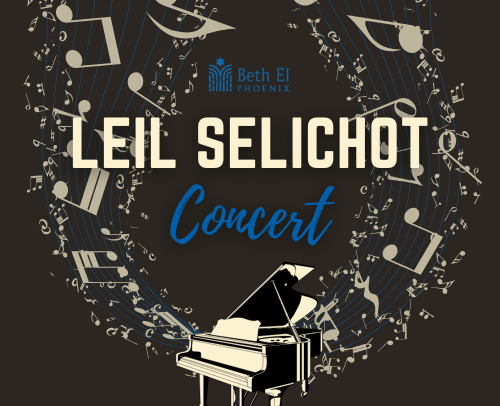Raboyseyee and Ladies,
ROSH HASHONO 2025 (5786)
The Remarkable Makeover of Selichos:
There was a time when we mamish hated going out to Selichos late on a Saturday night; it interfered with a movie we wanted to see and or a stop for some late-night pizza. As well, who among us, knew what the words meant and or, how to properly pronounce many of them? Its words are challenging even to those proficient in the language. The good news: That was then, but not anymore. And why is that? Who goes out to the movies these days? Who among us over sixty eats pizza late Saturday night? And today, we no longer need to know the words. We don’t? Shoin! More on that below, but let us begin here.
What the hec are Selichos? In short: Selichos are the ultimate spiritual pregame before Rosh Hashono and Yom Kippur, the time to get your soul in shape for the big days of judgement ahead. They are designed to act as a spiritual wake-up call before the Days of Awe; a way to review your sins and be ready on game day to seek the RBSO’s mercy. They are a blend of confessional prayers, poetic pleas, and meditative melodies.
Shoin, let’s talk tachlis (get real). Rosh Hashono is mamish around the corner. Yom Kippur too. The Days of Awe, the Yomim Noiro’im, the time when the RBSO pulls out His big scary book, His proverbial pen, and decides who’s gonna live, who’s gonna die, who’s gonna strike it rich, and who’s in for a troublesome year. Who’s gonna be eating chopped liver and who’s gonna be the chopped liver. And what better way to prepare for this annual heavenly audit than with some late night Selichos during which we skip most of the words and recite others that we don’t understand. Shoin.
This year, Selichos began this past motzei Shabbis and -reminiscent of “Moviefone” with Kramer’ – were featured either at 10:30pm, 12:00 midnight, 1:00 AM, as well as other select times. How all these times became acceptable is for another day.

There was a time when we derided going to selichos at midnight on Saturday night; it was the worst. Those late-night penitential prayers that scared the living daylights out of our zeides, get them crying, pounding their chests, and begging the RBSO for another year of life. But somewhere along the way -between Rav Saadya Gaon and MBD, between medieval Mainz and modern Five Towns, Selichos have certainly morphed. Big time. What started out as trembling in the dark has, in our day -and let’s be honest with one another in these days just before yom tov- become Saturday night Jewish entertainment. Say it’s not so but it is! Oy vey, what happened?! Is this good for the Jews? How did this happen? Is this kosher?
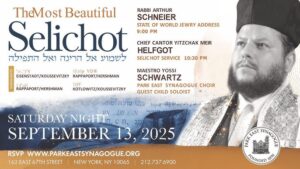
In the good old days (and by “good” I mean miserable), Selichos was no laughing matter. Picture it: The year is 900-something. The Geonim (our Sages) of Bavel are introducing these special prayers before Rosh Hashono. It’s midnight. The beis medrish is dark. The chevra are scared out of their kapotes. No one had air conditioning, no one had Starbucks, no one had guitars. Just serious, heavy-duty piyyutim in Aramaic that no one understood -even then. The message? Simple: Get into the right frame of mind. Cry now, maybe live later.
What are piyyutim you ask? Piyyutim (פיוטים, singular: piyyut) are basically Jewish liturgical poems — religious poetry written to be inserted into the formal prayers of the siddur or machzor. They’ve been around since the times of the Geonim and even earlier, and they are a huge part of Selichos, the High Holidays, and many other tefillos.
Let us fast forward to medieval Ashkenaz practices in Germany and France. The piyyutim got longer, the chazzan got louder, and Selichos night—especially the first motzei Shabbos—became an event. Still, it was a solemn one. This was not a concert. This was not a kumzitz. It was trembling in the dark, begging the RBSO to overlook our many misdeeds, need we list them?
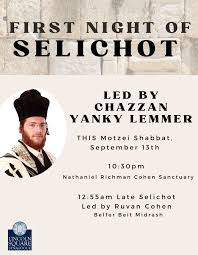
The bottom line: The Yiddin of old were not innocent bystanders; they had plenty of sins to worry about. Cheating in the marketplace, smuggling, some ate cake before davening, many mamish wiped down hard with towels after the mikveh on shabbis, oy vey! They didn’t need a Carlebach niggun; they needed divine mercy, pronto.
But then, along came the Baal Shem Tov and his merry band of spiritual revolutionaries. Suddenly, Yiddishkeit wasn’t only about fear and trembling; it was also about joy, niggunim, and dveikus (getting connected). And wouldn’t you know it? Selichos got a little facelift.
Then came the Chassidim who begam dancing with tears. The Chassidim introduced the concept that crying and singing can live side by side in the same tefillah. That a niggun without words could sometimes reach the RBSO faster than a 40-line piyyut full of Aramaic no one understood. So, in some shtetlach, Selichos started to sound less like a funeral dirge and more like a soulful jam session—with violins, clarinets, and hearts on fire.
Understatedly, the misnagdim rolled their eyes. “Selichos iz nisht kein simcha-dike zach,” they grumbled. “It’s supposed to be tears, not tambourines.” What are misnagdim you ask? Misnagdim (singular: Misnaged) were the Jews — mainly from Lithuania and surrounding regions — who strongly opposed the rise of Chassidus in the 18th century. But slowly, the balance shifted. And lo and behold, by the time we hit the 19th century, Selichos was no longer pure sackcloth-and-ashes. It had hints of joy, hints of music, and the beginnings of what would one day -in our times mamish- morph into the modern-day kumzitz.
Fast forward again, this time to the early 20th century. The Eastern European Yiddin were fleeing pogroms, arriving in America, and building big, fancy shuls all over Brooklyn, the Bronx, and later, on Long Island. And with those shuls came a new species of Jewish entertainer: the superstar chazzan.
Names like Yossele Rosenblatt, Moshe Koussevitzky, Richard Tucker to name a few. These were men who could hit a high C while simultaneously waking the dead. And Selichos night? That was their stage. The golden age of cantors was upon us. Shuls literally advertised Selichos like Broadway shows. Posters went up: “Come hear the world-famous Cantor So-and-So in a moving rendition of Selichos!” People came not just to daven but to be wowed. The shul was packed. The ladies’ gallery overflowed. Tickets were sold. And what was supposed to be a night of broken hearts became… a night at the opera.

Half the attends didn’t stay for the full Selichos. They came for the concert part, maybe klapped a few “O’shamnu’s,” and then went home to sleep. But hey—at least they came.
Let us go veyter. By the 1950s and 60s, back when the future Ois was a little boy, a number of shuls had choir lofts, big pipe organs, rabbis who gave long, boring speeches before Selichos, and kiddush clubs in the parking lot. And Selichos night? It became the kickoff event for the Yomim Noro’im.
First came a speech from the rabbi: “My dear friends, as we gather tonight to begin the solemn prayers of Selichos…” Then maybe an appeal, maybe a choir piece, maybe an announcement about the sisterhood bake sale. And then, finally, Selichos. By then half the crowd was asleep. You had to sell religion and Selichos was the perfect way to get people into shul, remind them that Rosh Hashono was next week, and maybe even convince them to buy High Holiday tickets before they were all gone.
And then raboyseyee, came the game-changer. The holy hippie himself (decades before the kosher Hippies, AKA: Ben Isaacs), the man, the legend, Reb Shlomo Carlebach hit the scene and made yet another change. A man who could walk into a room full of Jews, strum three chords on his guitar, sing “Am Yisroel Chai” forty-seven times, and suddenly everyone was crying, hugging, and promising to do teshuva—right after dessert. He was special.
Carlebach didn’t just sing. He transformed the whole Jewish landscape. He made music the language of spirituality. Suddenly, the heylige Toirah wasn’t only Gemora and Rashi; it was niggunim, it was warmth, it was the touchy feely “returning souls.” Many a yeshiva rebbe, enjoyed those times, if you chap. And Selichos was swept along for the ride. Instead of just whispering piyyutim no one understood, suddenly you had people swaying, humming, and even clapping. Carlebach was the king of Jewish music (Elvis the king of Rock). Carlebach was the original happy-clappy rabbi and today, kimat every orthodox community has at least one iteration the happy-clappy minyan fashioned and inspired by the master himself. Instead of the chazzan performing a one-man opera, you had the whole chevra singing along like it was campfire night in one of the myriad Catskill or Pennsylvania sleepaway camps.
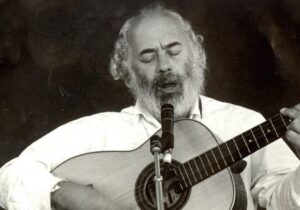
And guess what? People actually liked it. No longer was Selichos the dreaded midnight obligation that left you bleary-eyed and cranky the next day. It was a kumzitz with the RBSO. A chance to connect, to feel, to sing yourself into teshuva. Don’t the malochim (the RBSO’s angels) serenade Him? So says the heylige Gemora (Sanhedrin 38b): Malochim sing shira in shifts; they don’t all sing at once, they take turns.
Ober, what about the kalte-Yiddin? The yekkes, the misnagdim? Don’t ask, they are still in therapy. “Selichos iz nisht kein concert!” they shout. “This is supposed to be awe, not awesome!” But too late. The Carlebach wave had swept through the Jewish world, and once guitars were permitted in shuls as part of the Silichos, there was no going back from Kumzitz culture which has become the new Selichos.
By the 1980s and 90s, every kiruv group had figured it out. NCSY, Lincoln Square, Chabad, Aish, singles events, —they all knew the secret: you want to reach the people? You want their hearts? You sing to them! Better yet, you sing with them. A Jew who won’t sit through a 45-minute drasha will sit for three hours at a kumzitz, eyes closed, head swaying, hand on his friend’s shoulder, mumbling “Lulei Sorascha sha’ashu’ai” like he actually knows what it means. And guess what? It works on the girls and women too! Selichos also worked as a mood enhancer, if you chap, and they did. Singles -guys and girls- began flocking to Selichos by the thousands.
And why not? Shuls definitely fit more people than any motzei Shabbis party we attended. It became prime real estate for this stuff. It became the motzei shabbis late Saturday night activity. Instead of schlepping into a cold shul to mumble Aramaic, why not start with some music, some inspiration, some good vibes? And so it happened. In yeshivas, in shuls, in kiruv houses, Selichos morphed into the big Saturday night kumzitz. One came for the guitars, the drums, the singing in circles—and then, somewhere in the middle, you also read, and mumbled some Selichos. It was no longer “Selichos with music.” It was “music with Selichos.”
Let’s fast forward again—to today. The year is 2025. We are about to close the door on the Hebrew year 5785, and what is Selichos today? In many places, it’s an outright concert. Shuls literally advertise it like a music festival:
- “Join us for Selichos featuring Yaakov Shwekey and choir!”
- “Motzei Shabbos Selichos with Avraham Fried!”
- “Selichos under the stars—bring your guitars!”
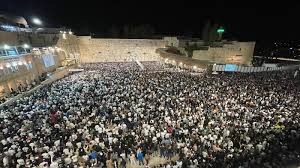
One can buy tickets. There’s a program. Maybe even a livestream for the folks at home. Snippets and feeds are all over Instagram and TikTok; it’s mamish a gishmak. No wonder Trump is about to make a deal to keep it alive; the Yiddin are demanding it! Selichos, the service that once struck fear into the hearts of trembling Jews, is now sold as a spiritual experience package deal. And it’s now mostly free!
People leave not with trembling knees but with recordings on their iPhones. And maybe, just maybe, that’s the point. As the world continues to turn and spin -some say out of control- maybe Selichos for the current generation is supposed to be less about fear and more about song, less about judgment and more about joy.
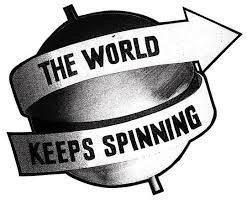
So, why did this happen? Let’s chazir (review). How did we go from Geonim whispering in Babylon to Shwekey, Lemmer, and many others, belting it out with a 30-piece band in Brooklyn College? A few reasons, raboyseyee:
- Nobody understands the Aramaic. Most of us barely chap the Hebrew of the machzor, never mind the obscure piyyutim of Selichos. Music fills the gap.
- Rabbis needed a hook. If you want the Yiddin to show up at midnight on a Saturday night, you’d better offer more than another incomprehensible service. Add some music, and suddenly you’ve got a crowd.
- Generational shift. Today’s Yiddin do not connect through fear like our zeides did. We’re spoiled. We like comfort, we like inspiration, we like “spiritual experiences.” We’re less into trembling, more into “feeling uplifted.”
- Carlebach + kiruv. Once Carlebach proved that music was the fastest way to the Jewish neshomo, the kiruv industry took it and ran. Selichos was the perfect time slot.
And maybe, just maybe, this isn’t a bug but a feature. Maybe the RBSO actually likes that we’ve turned Selichos into something we want to be at, instead of something we avoid like the plague.
Let’s pause and appreciate the irony. Selichos was supposed to be a night of fear, dread, trembling. Ober today? It’s a night of joy, song, and community. Our ancestors would walk into Selichos shaking, white as a sheet, convinced their fate hung by a thread. We walk in happily with guitars, cappuccinos, and WhatsApp groups sharing links to the best live-streamed concert. But is it effective? Absolutely.
The final bottom lines: Maybe this is exactly what the RBSO wants from us. Every generation has its path to teshuva. For the Geonim, it was fear. For the Chassidim, it was joy. For our grandparents, it was awe of the chazzan. And for us? It’s a kumzitz. It’s a concert. It’s music that gets us to open our hearts—even if we still don’t know what the Aramaic means.
The Rambam says that teshuva must come from love as well as fear. Rebbe Nachman says joy is the highest avoida. Maybe Selichos concerts are actually closer to the truth than the trembling whispers of old. Because at the end of the day, what matters is not how you got there, but that you said to the RBSO: “We’re sorry, we’ll try again, we still want You in our lives.”
And so, raboyseyee, as we gathered this past Motzei Shabbos for Selichos—whether in a small shtiebel with 11 men half-asleep, or in a mega-shul with a 10-piece orchestra and a guest appearance by Helfgott or Avraham Fried—remember this: the RBSO isn’t giving points for the tune. He’s looking at the heart.
May He write us in and grant us all a k’siva Va’chasima toiva, a year of health, parnosa and nachas. So happens that Moishe -in Sefer Devorim (Parshas Shoiftim 17:8-11) tells the Yiddin that things will change, that they must follow the Novee or the leaders of that day.
…וּבָאתָ אֶל־הַכֹּהֲנִים הַלְוִיִּם וְאֶל־הַשֹּׁפֵט אֲשֶׁר יִהְיֶה בַּיָּמִים הָהֵם…
“…You shall come to the kohanim, the Levites, and to the judge who will be in those days…”
Judaism keeps evolving to meet the needs of the people as does seemingly the technology available to feed those needs. It’s mamish a gishmak!
A gittin Shabbis & the Heylige Oisvorfer’s best wishes to all for a happy and healthy year ahead.
The Heylige Oisvorfer Ruv
Yitz Grossman
